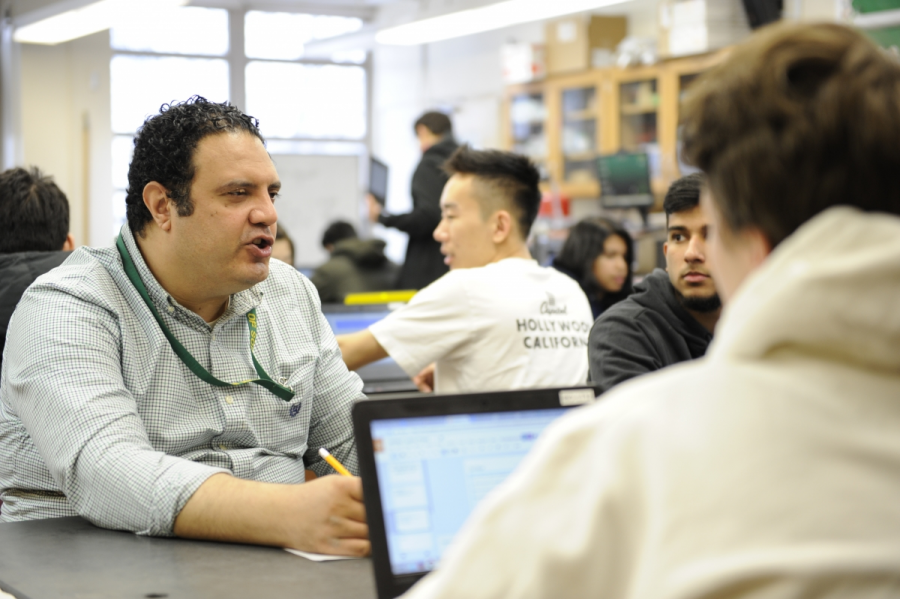Future of Gene-Editing Carries Hope and Uncertainty
One of the most commonly discussed concepts in Dr. Mahmoud’s post-AP Genetics class is the possible consequences of gene editing.
Last summer, a remarkable breakthrough was made in the world of science that could alter mankind’s role in nature for the remainder of time. In August 2017, it was announced that researchers at Oregon Health & Science University had successfully removed a mutation in human embryos that was linked to a common hereditary heart disease known as hypertrophic cardiomyopathy. This disease is linked to a dominant mutation in the MYBPC3 gene, which causes the heart muscle to thicken and is the leading source of premature death in young athletes.
This gene edit, the first of its kind to be tested on humans, was made possible with Clustered Regularly Interspaced Short Palindromic Repeats, or CRISPR-Cas9. How does this technology work? A specialized type of RNA unique to a gene is inserted into a genome that guides an enzyme called Cas9 to a particular location where the DNA’s double helix is separated, allowing geneticists to remove, add, and rearrange sequences to correct mutations.
Genome editing can create a genetically healthier society. Certain genes can be altered to improve disease-resistance, something already be

In post-AP Genetics, students have studied the advantages and disadvantages of gene expression in athletics as well as other fields
ing done for millions of crops, thereby increasing agricultural output. Applying the use of GMOs, or genetically modified organisms, to improve human life can eliminate several hereditary ailments from germlines, including cystic fibrosis, sickle cell anemia, and heart disease. This technology is even capable of reducing human susceptibility to disease, for example through the modification of mosquitoes with a malaria-resistant gene in the DNA.
This advancement can also give people greater control over their children’s genetic makeup. Certain genes can be modified to avoid gene mutations and hereditary ailments that would cost families thousands of dollars to treat later on in life. With almost 3-4% of infants worldwide born with a birth defect, gene-editing would save the global economy billions of dollars. Furthermore, children can live happier lives without the fear of succumbing to an unpredictable disease that may have originated from a single faulty gene.
However, this increased sense of control comes with several negative aspects. With the ability to alter one’s appearance through gene manipulation, parents may be interested in having ‘designer babies’ that have their ideal physical features, such as blue eyes or brown hair. This idea is not anything new – humans have been exploring ways to give themselves artificial enhancements for hundreds of years, utilizing anything from steroids to stimulants to gain an edge on their competitors. If parents are concerned with creating the next NBA star or Nobel Prize winner, gene-editing would allow them to design a child with suitable characteristics. Additionally, mothers who have exposed their children to drugs and alcohol during their pregnancies would want to reverse their irresponsible behaviors by editing the mutated genes of their children.
“Aesthetic enhancements would also create a
social divide.”
The risks of these aesthetic enhancements would also create a social divide between those who have access to and can afford gene modification and those who cannot. A germline modification from the Harvard University Stem Cell Institute can cost anywhere from $16,500 to $19,100, not a small figure for the average person. Those who cannot afford the enhancements — including the 40 million Americans reported living below the poverty line in 2016 by the U.S. Census Bureau — would be left behind. The concept of a ‘class conflict’ has appeared in a wide range of philosophy, literature, and film, from Karl Marx to ‘Brave New World’ to ‘GATTACA’, a 1997 movie that explored a future of genetic characteristics dictating one’s placement in society. These fictional tales have considered the concerns of technology moving too quickly to the point where power is concentrated among the elite who can determine a caste system for everyone else to follow. In a time of political and social turmoil, it is time for us take these possibilities more seriously.
With these implications of gene-editing on the horizon, it is clear that there should be increased restrictions on who has access to the DNA-altering technology and for what purposes it should be used. GMO production is already under regulation in United States, primarily focusing on the nature of the products rather than the process by which they are made. In Europe, the general consensus is that GMO use should be avoided with the numerous restrictions being placed upon its development. If GMOs for agriculture are already under scrutiny, then why should CRISPR be treated any differently? Gene-editing research should be thoroughly reviewed at every step of the process to ensure that there are no malicious intentions within the technology.
To ensure that the life-altering power of gene-editing does not fall into the wrong hands, restrictions need to be placed upon its use. In the short term, colleges, universities, and not-for-profit research groups should be allowed to study the possibilities of CRISPR and other software after approval. This would involve finding and correcting common mutations in DNA sequences before implementing these discoveries into human patients. Although it is said that competition leads to innovation, there should be strict limitations for biotech companies that plan on marketing gene-editing to consumers.
James Snyder is a crossword editor and Staff Reporter for ‘The Science Survey’ as well as a Student Life Section Editor and sports photographer for...











